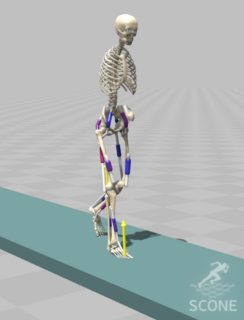ID 2405: BeReal: Simulating the interaction between human and a non-ideal treadmill
Master’s thesis
Predictive simulations are commonly used to replicate human motion. If our simulation result matches what we observe in experiments, this can help us understand how human motion is controlled and why humans choose to walk as they do.
So far, all reflex-based predictive models simulate overground walking, whereas most experimental studies are carried out on a treadmill since this allows for longer and continuous measurements. However, the kinematics of overground and treadmill walking differ. One reason for this is the energy transfer between the human and the treadmill belts, which is a result of the non-ideal behavior of the treadmill. When the human steps on the belt, it will slow down slightly, before returning to its original speed. This temporary speed decrease is also referred to as intra-stride belt-speed variation [1,2]. It depends on the treadmill motor, but also the mass and walking speed of the human [3].
We recently developed a treadmill model for predictive simulations in the framework SCONE. However, our model assumes the treadmill belts behave ideally, meaning that they always run at the prescribed speed and that the energy transfer between humans and treadmills is neglected.
This thesis aims to develop and evaluate a realistic model of the treadmill that can be used for predictive simulations. We hypothesize that by taking into account intra-stride belt-speed variations, the simulated kinematics and physiological variables (e.g. metabolic cost) will match the experimental data of treadmill walking more closely than our current treadmill model and an overground model.
Tasks / Details
- you will develop a realistic treadmill model in the predictive simulation framework SCONE that considers the interaction between human and treadmill belt-speed.
- you will evaluate the model by comparing kinematic and physiological simulation results to experimental data and existing models.
- you will get the chance to also record experimental data of treadmill walking in our biomechanics lab.
Requirements
- strong interest in biomechanics and simulation
- ideally first experience with the software framework SCONE (or Opensim) [this is however not am exclusion criterion]
- independent working style
- interest in hands-on experience by acquiring / working with motion capture data
Supervisors
References
[1] Savelberg HH, et al.: Intra-stride belt-speed variation affects treadmill locomotion. Gait Posture. 1998
[2] Sloot LH, et al.: Energy exchange between subject and belt during treadmill walking. JBiomech. 2014
[3] Tielke A, et al.: Non-ideal behavior of a treadmill depends on gait phase, speed, and weight. Sci.Rep. 2019


